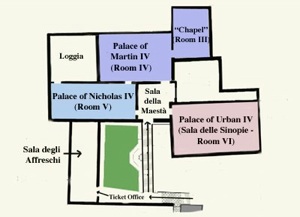
This room is in the rib-vaulted space in the square tower to the right of the far wall of the palace of Pope Martin IV. It is usually referred to as the chapel, although there is no evidence that it performed this function. It is more likely that the tower was conceived as a defensive bastion for the palace.
Traces of decorative frescoes (1290s) survive above the entrance, in some of the windows and along the top of some of the walls. These frescoes employ a repetitive grey and white pattern [punctuated with the papal insignia of crossed keys ??]
[?] Reliquary of St Sabinus (ca. 1340)
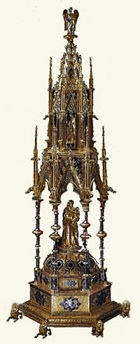
The cranium of the saint is housed under the cupola above the hexagonal base of the reliquary. Three golden figures adorn the higher registers::
-
✴the Madonna and Child stand above the cupola;
-
✴St Sabinus stands in the register above it; and
-
✴an angel at the top, which was added in the second half of the 19th century to replace an earlier figure.
The six enamels in the base depict scenes from the life of St Sabinus.
[?] Panel from a Diptych (ca. 1350)
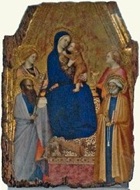
[5] Two Apostles (ca. 1280)
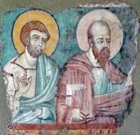
[6] Two censing angels (13th century)
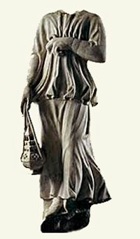
[Could they have come from the other two Cardinals’ monuments in San Domenico of 1272-3 ???]
[9, 10] Coronation of the Virgin and a Virtue (ca. 1349)
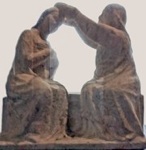

These small figures, which are attributed to the workshop of Andrea Pisano, are unfinished. They were probably intended for the Duomo.
[13] Madonna and Child (ca. 1347)
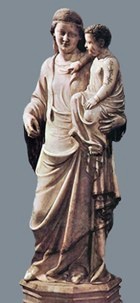
[8, 15, 16] Other Figures of the Standing Madonna and Child
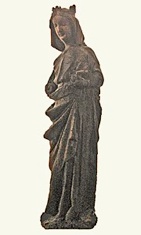

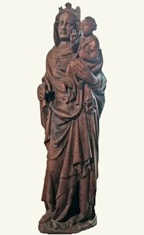
From: Santa Lucia SS Severo e Martirio San Giovanni Evangelista
This group includes three works of known provenance:
-
✴A small wooden figure (ca. 1300) of the Virgin is from Santa Lucia dei Canonici. This figure originally depicted the standing Madonna and Child, but it was subsequently modified to represent St Lucy, at which point the figure of the baby Jesus was replaced by lamp. This figure of the baby Jesus has since been lost. The female figure has been returned as far as possible to its original form, but the arms have been destroyed. [15]
-
✴An originally polychrome statue (ca. 1300), which is carved from pear wood, came from the Abbazia di SS Severo e Martirio. It has been badly damaged by an infestation of insects. The baby Jesus holds a robin, as a symbol of His future sacrifice. [8]
-
✴A large wooden statue (ca. 1335) came from San Giovanni Evangelista. The baby Jesus holds an orb and raises His right hand in blessing. The Madonna holds [a broken staff ??] [16]
[17] Christ and Angels (1347-8)
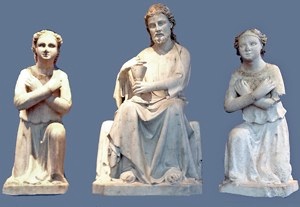
These figures came from an altar in the left of the nave of the Duomo that might have housed the Sacro Corporale while the Cappella del Corporale was in construction. They were moved from the Duomo to the plinths in the exterior lunette of the Porta del Corporale in 1890, and the angels were subsequently badly damaged. They were removed from this location in 1985.
-
✴The figure of Christ is attributed to Nino Pisano. He is seated and holds a chalice in His right hand: the wafer that was originally in His left hand has been lost.
-
✴The two angels (both of which have been damaged) were probably those that were made from the marble that Andrea Pisano (see above) sent to the Duomo in ca. 1347. They are of inferior quality and are attributed to Tommaso Pisano.
[18] Madonna and Child Enthroned (ca. 1270)
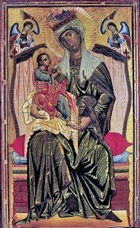
The altarpiece was moved to the counter-facade at some point (probably in the 1320s to make way for what is now called the Gardner Polyptych - see below). However, it was translated back to the high altar in 1733 after a miracle in which the Madonna was seen to weep tears of blood. It was documented on the high altar of the new church in 1861, at which point the Madonna and Child each wore a golden crown that had been affixed as a votive offering and the altarpiece was covered by another painting (presumably for protection). The panel, which has been slightly spoiled by repainting and is cropped at the bottom, was restored in 1927-8.
The altarpiece was stolen in 1953 and the thieves tried to sell it to the National Gallery, London. The authorities were alerted and the altarpiece was recovered. It was restored againin 1965-70, when some of the repainting was removed. The traditional attribution to Coppo di Marcovaldo was reinforced at this point, although still not to the satisfaction of all scholars. The altarpiece finally found way back to Orvieto in 1984 and was returned to Santa Maria dei Servi before being transferred to the museum for security reasons.
[19] Crucifix (13th century)
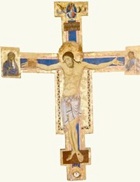
[20] Madonna and Child (13th century)
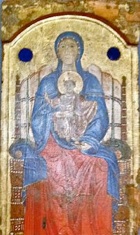
The icon depicts the Madonna and Child enthroned. The "Child" is represented as an adult wearing a toga: He holds the Gospel in His left hand and raises His right hand in blessing.



